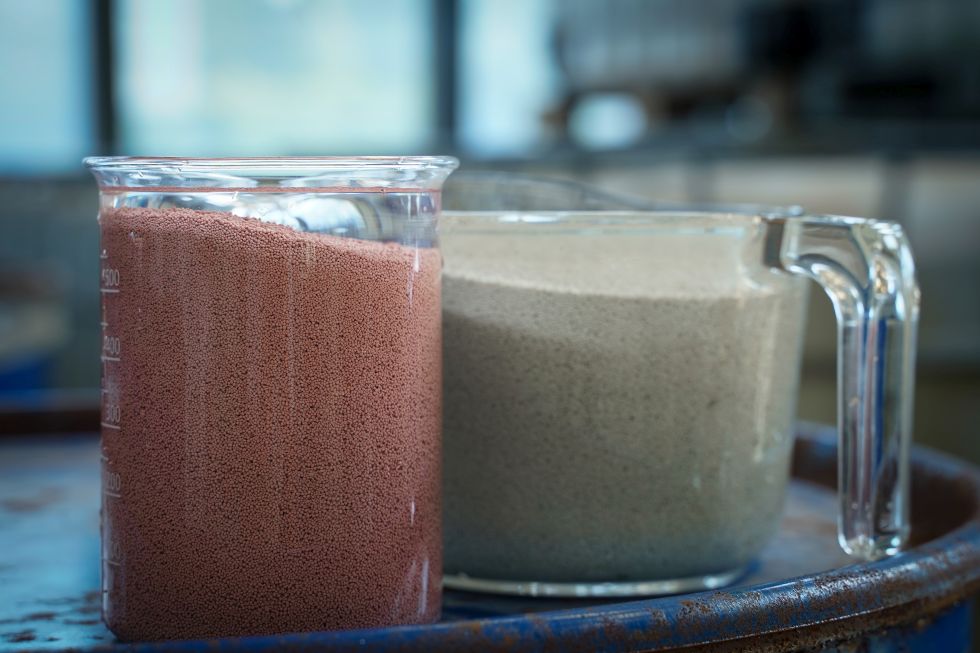Several types of regenerable adsorbents
Image gallery

Properties
- Subtitle To remove arsenic, fluorine, boron, iodine, iron, manganese, ammonia
- Video
- Product sheet
Content
Our own regenerable adsorbents based on cerium hydroxide and zeolite remove arsenic, fluorine, boron, iodine, iron, manganese, and ammonia from the water. Offered in bulk filtration form, it is an excellent solution for waterworks, water companies, and other industrial water management service providers. Our adsorbents have all the necessary regulatory approvals for operation and distribution. During cleaning, when the adsorbent has reached the limit of its capacity (3-24 months depending on the water quality), regeneration with commercially available chemicals is necessary (duration: 7 hours). This process takes place in our factory, where the contaminated adsorbent is safely treated. After regeneration, the purified adsorbent is returned to the cleaning technology, reducing the waste generated.
Product benefits:
- cerium-based adsorbent resin - flexible use for all waterworks and water industry operators
- adsorbent life is 7-10 years
- can be regenerated
- a cost-effective, environmentally friendly solution
- works with water flow
- does not change other parameters of drinking water (taste, smell)
- can also be fitted as an adapter at the end of an existing technology line

MET PRODUCT/ADSORBENT FAMILY MEMBERS:
- AsMET - arsenic remover
- BoMET - boron remover
- IoMET -iodine remover
- FluMET - fluoride remover ZMET - iron, manganese, ammonia remover
AREAS OF APPLICATION:
- water utility service providers, water technology companies
- municipal and industrial wastewater treatment companies
- technological water treatment of thermal power plants, mines, and other factories
- bottling plants
- vegetable, fruit, and food processing industries
ASMET FOR DRINKING WATER TREATMENT
- reduces arsenic concentrations below 1 μg/l (WHO standard 10 mg/l)
- binds As (III) and As (V) in water
- the temperature of the water to be treated must not exceed 50 °C - can also be used in some thermal springs
- In contrast to conventional and chemical-intensive arsenic mitigation methods, AsMet is a specially developed filter resin that offers a cost-effective, sustainable, and economical solution for water treatment
FLUMET WASTEWATER TREATMENT
- for steel, aluminium, semiconductor and other related industries
- pH and redox substances must be controlled by pre-treatment
- pH between 3 and 3,5 is optimal
- reduce the fluoride ion content of treated water to below 1 mg/l
- the maximum fluoride concentration is 30 mg/l
BOMET FOR THE TREATMENT OF DRINKING WATER AND SEAWATER
- for the treatment of drinking water and the removal of boron from seawater above the sanitary limit value, which is removed by desalination
- best results in boron reduction between 30 and 300 mg/l boron
- production of boron-free sea salt
ZMET FOR THE TREATMENT OF DRINKING WATER
- made from ground natural zeolite mined in Hungary
- for the removal of general cation exchange potential, ammonia, phosphates, iron, manganese, etc.
IOMET FOR DRINKING WATER TREATMENT AND RADIOACTIVE WASTE DISPOSAL
- removal of unhealthy levels of iodine in drinking water
- removes I-131 radioactive iodine by filtering out radioactive iodine
- the adsorbent reduces/ mitigates radioactive contamination of contaminated water
Vietnam Arsenic removal
Intro
Our expansion into the Far East began with Vietnam, where arsenic contamination of drinking water is a huge problem
Properties
- Subtitle
Arsenic-removal tanks
Intro
Our company placed its PuraWell arsenic-removing tank at the kindergarten of Rinyaújlak fitted to a wall fountain.
Properties
- Subtitle
Purawell system for clean drinking water
Intro
Our company handed over 15 pieces of AsMet arsenic removal equipment with a capacity of 12 m3/ d to Subotica Waterworks
Properties
- Subtitle



